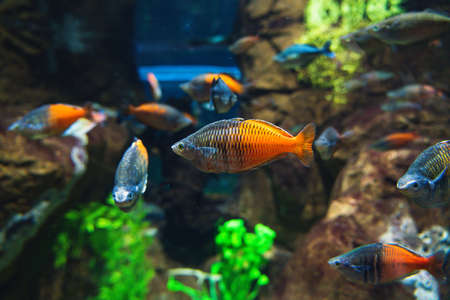Embracing British Aquascaping Aesthetics
When designing a freshwater or marine aquarium in the UK, drawing inspiration from the very landscapes that define Britain can bring a unique and comforting sense of home to your aquatic environment. Consider incorporating elements reminiscent of classic English gardens—think lush native greenery such as water crowfoot or hornwort, paired with subtle stonework evocative of the Lake District’s rugged outcrops or the gentle curves of a Cotswold stream. These touches not only create an inviting, locally-inspired atmosphere for your fish but also resonate with the traditional aesthetics found throughout the British countryside. By blending native plants with natural stones and driftwood, you can craft a tank that feels both familiar and distinctly British, evoking the serenity of wild moorlands or a tranquil garden pond right in your living room. This approach offers not just visual appeal but also a meaningful connection to local heritage, making your aquascape a true reflection of Britain’s timeless charm.
Choosing Suitable Freshwater and Marine Species
When planning an aquascape for your British aquarium, selecting the right fish and invertebrates is crucial for both the health of your tank and the success of your design. The UK offers a rich variety of freshwater and marine species that are well-suited to local water conditions, which tend to be moderately hard with neutral to slightly alkaline pH in most regions. By choosing species commonly available through reputable UK aquatic shops and supported by local hobbyist communities, you ensure that your aquarium inhabitants will thrive, making maintenance smoother and more enjoyable.
Freshwater Favourites for British Tanks
For freshwater setups, it’s best to start with hardy species that are adaptable to the ambient temperature and water parameters found in British homes. Below is a table highlighting popular choices along with their key care requirements:
| Species | Water Temperature | pH Range | Community Suitability |
|---|---|---|---|
| White Cloud Mountain Minnow | 16-22°C | 6.0-8.0 | Excellent for peaceful tanks |
| Bristlenose Pleco | 20-26°C | 6.5-7.5 | Ideal algae eater, calm nature |
| Corydoras Catfish | 20-24°C | 6.0-7.5 | Active bottom-dweller, sociable |
| British Native Stickleback* | 10-20°C | 7.0-8.0 | Interesting native choice (check local regulations) |
| Zebra Danio | 18-24°C | 6.5-7.5 | Lively and robust shoaler |
*Note: Always check legal guidelines before collecting native species.
Marine Species Thriving in UK Aquaria
If you’re drawn to marine aquascapes, look for species that are regularly stocked by UK marine suppliers and have proven records in similar water conditions:
| Species/Invertebrate | Water Temperature | Salinity (SG) | Aquarium Role/Compatibility |
|---|---|---|---|
| Common Clownfish (Amphiprion ocellaris) | 24-26°C | 1.020–1.025 | Hardy, iconic, pairs well with soft corals and anemones* |
| Banggai Cardinalfish (Pterapogon kauderni) | 24-27°C | 1.020–1.025 | Shoaling fish, peaceful temperament |
| Cleaner Shrimp (Lysmata amboinensis) | 24-27°C | 1.023–1.025 | Aids in tank hygiene, striking appearance |
| Turbo Snail (Turbo spp.) | 22-25°C | 1.022–1.025 | Naturally manages algae growth on decor and substrate |
| Dwarf Hermit Crab (Clibanarius spp.) | 22-26°C | 1.023–1.025 | Cleans detritus, compatible with most reef tanks |
*When keeping anemones, ensure mature tank stability and adequate lighting.
The Benefits of Choosing Locally Supported Species
Selecting species commonly kept by UK aquarists means you’ll have ready access to advice from local aquatic clubs and online forums such as Practical Fishkeeping or The British Cichlid Association. Local shops often provide fish that are already acclimatised to British tap water, reducing stress on new arrivals and increasing their resilience. Ultimately, matching your aquascape inhabitants to your region’s resources ensures a healthy, beautiful tank that reflects both global inspiration and British practicality.

3. Selecting Eco-friendly Materials and Décor
When aquascaping in the UK, choosing sustainable and environmentally conscious materials is not only a matter of personal ethics but also aligns with British regulations and values concerning aquatic ecosystems. Ensuring that your aquarium’s hardscape and decorative elements are both beautiful and kind to the environment is essential for responsible fishkeeping.
Sourcing Sustainable Hardscape Materials
Opt for natural stones and woods that have been ethically sourced. In the UK, it’s best to avoid collecting rocks, driftwood, or plants from wild habitats, as this can disrupt local ecosystems and may breach environmental laws. Instead, purchase from reputable aquatics suppliers who can confirm their products are responsibly harvested or created. Look for FSC-certified woods or repurposed materials where possible, supporting British efforts towards sustainability.
Eco-friendly Substrates
Select substrates such as natural gravel or sand that do not contain artificial dyes or harmful chemicals. These options are safer for your fish and reduce the risk of introducing pollutants into your tank. Many UK aquatics stores now offer eco-friendly substrate choices made from recycled or sustainably extracted resources.
Decorative Elements That Align with British Values
When choosing ornaments, prioritise those made from recycled glass, ceramics, or locally produced materials to lower your aquarium’s carbon footprint. Avoid plastic decorations that may degrade over time or release microplastics into the water. For themed tanks inspired by British heritage, consider hand-crafted items from local artisans or upcycled treasures—these add character while supporting small businesses and sustainability goals.
By making thoughtful choices about your aquascaping materials and décor, you create a visually stunning underwater scene while respecting Britain’s commitment to conservation and environmental stewardship. This approach ensures your fish tank remains a safe haven for its inhabitants and a positive example within the wider fishkeeping community.
4. Creating Naturalistic Layouts
If you want your British freshwater or marine aquarium to feel truly authentic, naturalistic layouts are key. Mimicking local riverbeds, lakes, and coastal rockpools not only offers a beautiful display but also provides your fish with an environment closely matching their native habitats. Here’s how to establish thriving biotopes using British-sourced plants and substrates.
Tips for Mimicking Local Environments
- Research Your Region: Identify which rivers, lakes, or coastline you wish to recreate. The River Thames, Lake District waters, and Cornish rockpools each have distinct characteristics.
- Substrate Selection: Use gravel, sand, and pebbles sourced from reputable UK suppliers. Choose textures and colours that reflect your chosen habitat — fine sand for lowland rivers, coarser gravel for upland streams, or a mix for rocky shorelines.
- Natural Hardscape: Incorporate locally collected stones (make sure they’re aquarium-safe) and weathered driftwood. These provide hiding spots and structure for both fish and invertebrates.
British-Sourced Plants for Authenticity
| Habitat Type | Recommended Native Plants |
|---|---|
| Riverbeds & Streams | Water starwort (Callitriche stagnalis), Hornwort (Ceratophyllum demersum) |
| Lakes & Ponds | Pondweed (Potamogeton natans), Water milfoil (Myriophyllum spicatum) |
| Coastal Rockpools | Bladderwrack (Fucus vesiculosus) – in marine tanks only |
Aquascaping Tips for a Thriving Biotope
- Diverse Planting: Arrange taller plants at the back and sides, with lower-growing species at the front to create depth and visual interest.
- Create Microhabitats: Use rocks and wood to form small caves and crevices — perfect shelters for shy native species like sticklebacks or gobies.
- Sensitive Stocking: Select fish and invertebrates that naturally occur together in your chosen region for harmonious community dynamics.
Sourcing Ethically & Legally
Always ensure your plants and hardscape materials are sourced responsibly from UK-based aquatics retailers. Never collect wild specimens without permission; many habitats are protected by law to safeguard native wildlife.
5. Lighting and Climate Considerations
When aquascaping in the UK, lighting and climate play a crucial role in maintaining both the visual appeal of your tank and the wellbeing of its inhabitants. The British climate is famous for its variability—long, dark winters and short, sometimes intensely bright summers—so it’s essential to adapt your aquarium setup to these changing conditions.
Adapting Tank Lighting for British Seasons
During the winter months, natural daylight hours are limited, which can affect both plant growth and fish behaviour. To compensate, consider investing in high-quality LED aquarium lights with programmable settings. These allow you to simulate longer daylight periods, encouraging healthy plant photosynthesis and helping fish maintain their natural rhythms. In summer, the opposite problem may arise; too much ambient light from windows can lead to algae blooms. Position tanks away from direct sunlight and use adjustable blinds or curtains if necessary.
Temperature Control Throughout the Year
The UK’s seasonal temperature swings mean that heating and cooling solutions are equally important. In winter, reliable submersible heaters ensure that tropical species remain comfortable even when room temperatures drop. Look for models with built-in thermostats for precise control, and check water temperatures regularly. In warmer weather, especially during heatwaves, tanks can overheat quickly. Use fans to increase evaporation and keep lids slightly ajar to encourage airflow—but always monitor humidity levels to prevent condensation issues.
Routine Adjustments and Monitoring
Make it a habit to adjust your lighting schedules and heater settings as the seasons change. Automatic timers can be a lifesaver, ensuring consistency even when life gets busy. Regularly inspect your equipment for signs of wear or malfunction; this proactive approach helps avoid sudden shocks to your aquatic community. By tailoring your aquascape’s environment to the UK’s unique climate patterns, you’ll create a stable, thriving ecosystem that looks beautiful all year round.
6. Maintenance Routines for Busy British Lifestyles
Maintaining a beautiful aquascape in the midst of busy British routines can seem daunting, but with a few smart strategies, you can ensure your freshwater or marine tank remains healthy and thriving. The key is to weave aquarium care seamlessly into your work and family commitments.
Weekly Habits: Small Tasks, Big Impact
Allocate just 10-15 minutes twice a week for basic checks—test water parameters while the kettle boils or during a quiet moment after tea. Use this time to inspect fish health, prune plants, and remove any visible debris. These small, regular actions prevent problems from building up, saving time in the long run.
Water Changes Made Easy
Rather than large, disruptive water changes, opt for frequent small top-ups—about 10% weekly. This approach fits easily around hectic schedules and supports stable water chemistry, essential for both native British species and more exotic marine inhabitants.
Automate Where Possible
Embrace technology to lighten your load. Automatic feeders, timer-controlled lighting, and filter cleaning alerts can all help streamline maintenance. Many UK aquarists find these tools invaluable during school runs or busy office periods.
Family Involvement: Shared Responsibility
Getting children involved fosters responsibility and interest in aquatic life. Assign simple tasks like feeding or plant trimming. Sharing duties ensures no single person feels overwhelmed, turning tank care into quality family time.
Seasonal Adjustments
The British climate brings unique challenges—adjust heater settings as temperatures drop in winter or use fans to cool tanks in summer heatwaves. Regularly check equipment after storms or power cuts common in certain regions.
Long-Term Success
Aquascaping thrives on routine. By integrating short, frequent care sessions into daily British life and making use of modern gadgets, your aquascape will flourish without taking over your schedule—leaving you free to enjoy both your tank and your treasured downtime.


